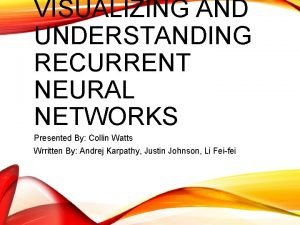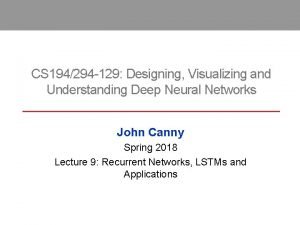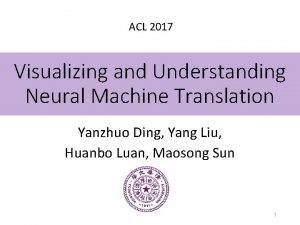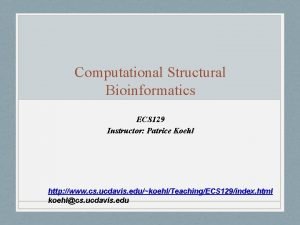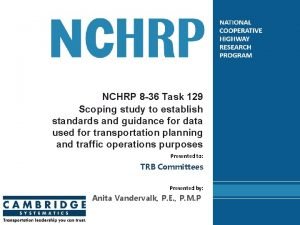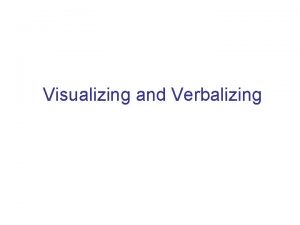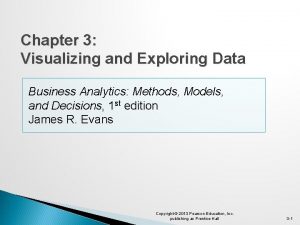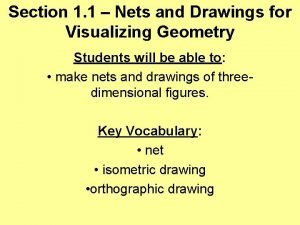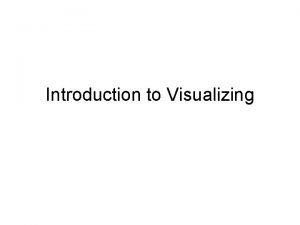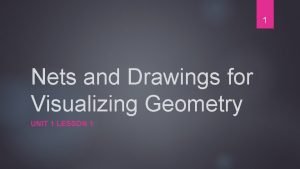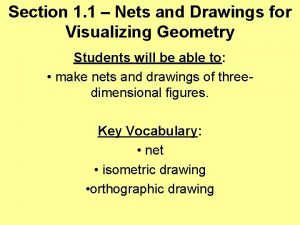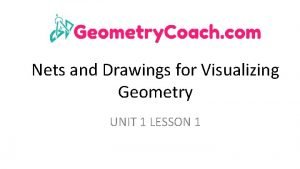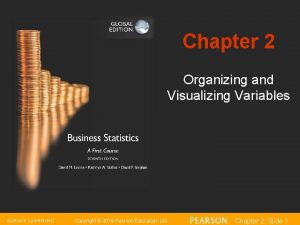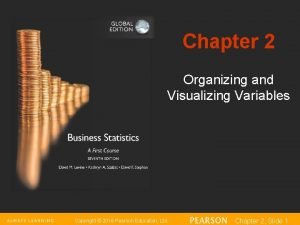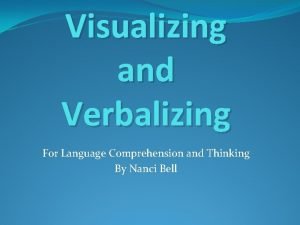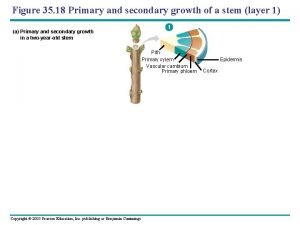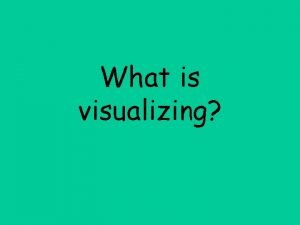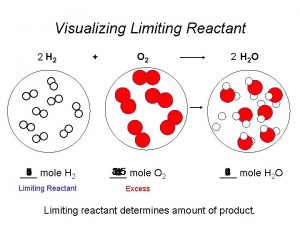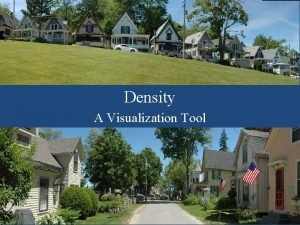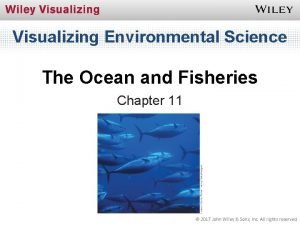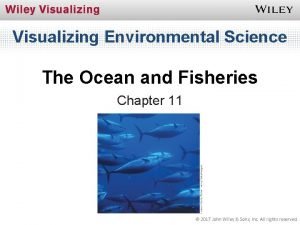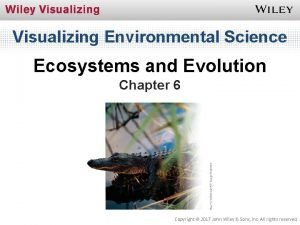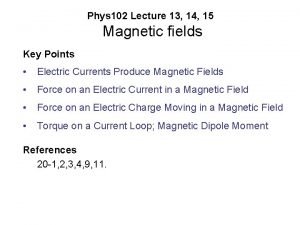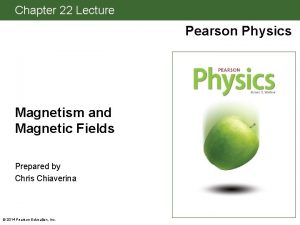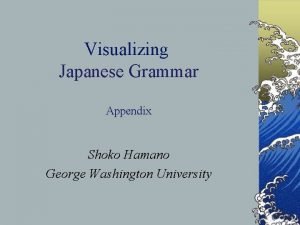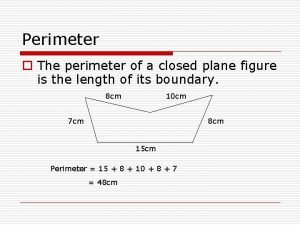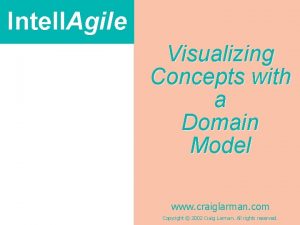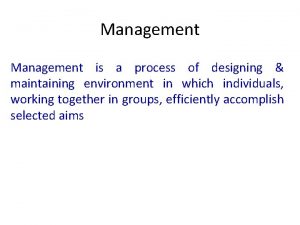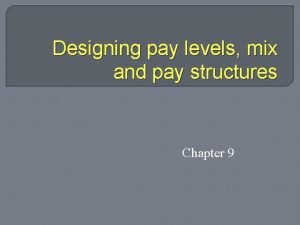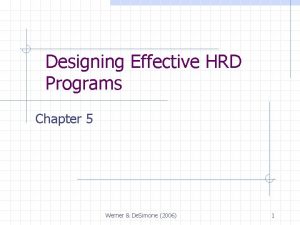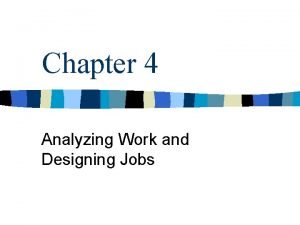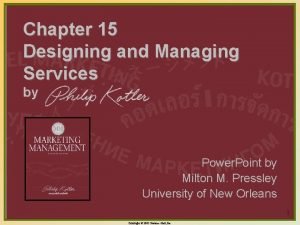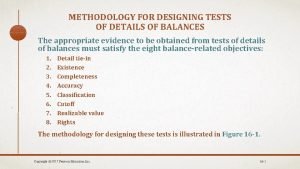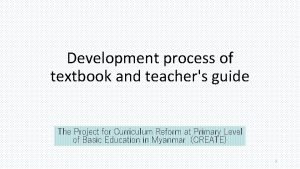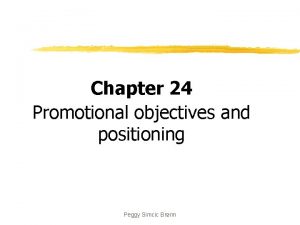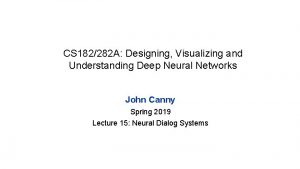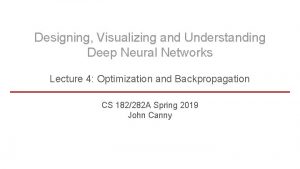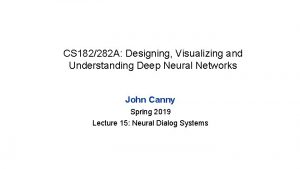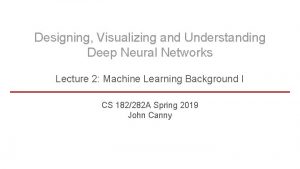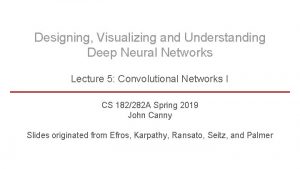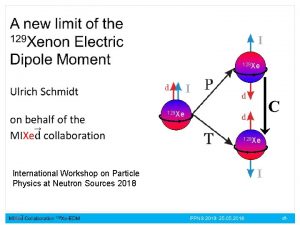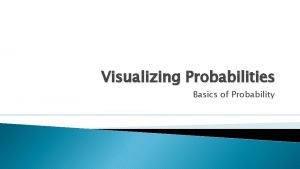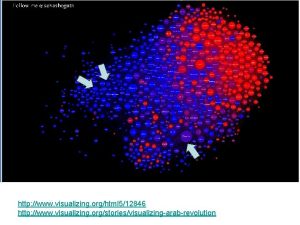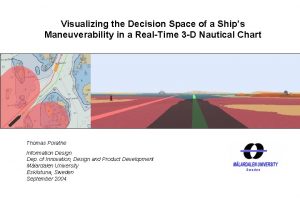CS 194294 129 Designing Visualizing and Understanding Deep
































































- Slides: 64

CS 194/294 -129: Designing, Visualizing and Understanding Deep Neural Networks John Canny Spring 2018 Lecture 14: Translation

Last Time: Soft vs Hard Attention Soft attention Hard attention: Attend to a single input location, can’t use gradient descent, Need reinforcement learning. Soft attention: Compute a weighted combination (attention) over some inputs using an attention network. Can use backpropagation to train end-to-end. Based on cs 231 n by Fei-Fei Li & Andrej Karpathy & Justin Johnson

Last Time: Recurrent Attention for Captioning Distribution over L locations a 1 CNN Image: Hx. Wx 3 Distribution over vocab a 2 h 0 d 1 a 3 h 1 d 2 h 2 Features: Lx. D Weighted features: D Weighted combination of features z 1 y 1 First word Based on cs 231 n by Fei-Fei Li & Andrej Karpathy & Justin Johnson z 2 y 2

Last Time: Attention Mechanics: Salience During training, the attention layer receives gradients which are the product of the upstream gradient and the feature layer activations (salience). Activations Feature Layer A Gradient C B Attention Weights Attention gradients are products of activation and upstream gradient, summed over features. This is a salience (importance) signal.

Last Time: Attention and Interpretability Attention models learn to predict salient (important) inputs. Attention visualizations help users understand the causes of the network’s behavior. Not every attended region is actually important, but post-processing can remove regions that aren’t.

This Time: Translation • Sequence-to-sequence translation • Adding Attention • Parsing as translation • Attention only models • English-to-English translation ? !

Sequence-To-Sequence RNNs An input sequence is fed to the left array, output sentence to the right array for training: For translation: I love Amo coffee <EOS> el Amo café <EOS> el café

Sequence-To-Sequence RNNs Generation: I love coffee Amo Me el gusta café el <EOS> Amo Me el gusta <EOS> café el <EOS> café Keep an n-best list of partial sentences, along with their partial softmax scores.

Bleu scores for Translation The goal of bleu scores is to compare machine translations against humangenerated translations, allowing for variation. Consider these translations for a Chinese sentence: Candidate 1: It is a guide to action which ensures that the military always obeys the commands of the party. Candidate 2: It is to insure the troops forever hearing the activity guidebook that party direct.

Bleu Scores for Translation Candidate 1: It is a guide to action which ensures that the military always obeys the commands of the party. Candidate 2: It is to insure the troops forever hearing the activity guidebook that party direct. Reference 1: It is a guide to action that ensures that the military will forever heed Party commands. Reference 2: It is the guiding principle which guarantees the military forces always being under the command of the Party. Reference 3: It is the practical guide for the army always to heed the directions of the party.

Bleu Scores for Translation Candidate 1: It is a guide to action which ensures that the military always obeys the commands of the party. Candidate 2: It is to insure the troops forever hearing the activity guidebook that party direct. Reference 1: It is a guide to action that ensures that the military will forever heed Party commands. Reference 2: It is the guiding principle which guarantees the military forces always being under the command of the Party. Reference 3: It is the practical guide for the army always to heed the directions of the party.

Bleu Scores for Translation Candidate 1: It is a guide to action which ensures that the military always obeys the commands of the party. Candidate 2: It is to insure the troops forever hearing the activity guidebook that party direct. Reference 1: It is a guide to action that ensures that the military will forever heed Party commands. Reference 2: It is the guiding principle which guarantees the military forces always being under the command of the Party. Reference 3: It is the practical guide for the army always to heed the directions of the party.

Bleu Scores for Translation

Bleu Scores for Translation Candidate 1: It is a guide to action which ensures that the military always obeys the commands of the party. unigram precision 17/18 Candidate 2: It is to insure the troops forever hearing the activity guidebook that party direct. unigram precision 8/14 Reference 1: It is a guide to action that ensures that the military will forever heed Party commands. Reference 2: It is the guiding principle which guarantees the military forces always being under the command of the Party. Reference 3: It is the practical guide for the army always to heed the directions of the party.

Bleu Scores for Translation

Bleu Scores for Translation Candidate 1: It is a guide to action which ensures that the military always obeys the commands of the party. bigram precision 10/17 Candidate 2: It is to insure the troops forever hearing the activity guidebook that party direct. bigram precision 1/13 Reference 1: It is a guide to action that ensures that the military will forever heed Party commands. Reference 2: It is the guiding principle which guarantees the military forces always being under the command of the Party. Reference 3: It is the practical guide for the army always to heed the directions of the party.

Bleu Scores for Translation How to combine scores for different n-grams? Averaging sounds good, but precisions are very different for different n (unigrams have much higher scores). BLEU Score: Take a weighted geometric mean of the logs of n-gram precisions up to some length (usually 4). Add a penalty for too-short predictions. Candidate length c shorter than reference r translation

Sequence-To-Sequence Model Translation Encoder Decoder A depth-2 model I love coffee Amo Me el gusta <EOS> Amo Me café el el gusta <EOS> café el <EOS> café Beam search width = 2

Sequence-To-Sequence Model Translation Raw scores for French-English Translation, depth = 4 Reversed = reverse the order of the input sentence. Intuition: the first part of the sentence is the most important, and reversal eases the long-term dependencies from output to input sentence. From Sutskeyver et al. “Sequence to Sequence Learning with Neural Networks” 2014.

Sequence-To-Sequence Model Translation Input sequence reversal A depth-2 model coffee love I Amo Me el gusta <EOS> Amo Me café el el gusta <EOS> café el <EOS> café Beam search width = 2

Sequence-To-Sequence Model Translation Raw scores for French-English Translation, depth = 4 Beam sizes are tiny!! The model produces state-of-the-art translations with almost no search. From Sutskeyver et al. “Sequence to Sequence Learning with Neural Networks” 2014.

Sequence-To-Sequence Criticisms All the information from the source sentence has to pass through the bottleneck at the last unit(s) of the encoder. Sentence length varies, but the encoding always has a fixed size.

Soft Attention for Translation “I love coffee” -> “Me gusta el café” Bahdanau et al, “Neural Machine Translation by Jointly Learning to Align and Translate”, ICLR 2015 Based on cs 231 n by Fei-Fei Li & Andrej Karpathy & Justin Johnson

Soft Attention for Translation Distribution over input words "I love coffee” -> “Me gusta el café” Bahdanau et al, “Neural Machine Translation by Jointly Learning to Align and Translate”, ICLR 2015 Based on cs 231 n by Fei-Fei Li & Andrej Karpathy & Justin Johnson

Soft Attention for Translation Distribution over input words "I love coffee” -> “Me gusta el café” Bahdanau et al, “Neural Machine Translation by Jointly Learning to Align and Translate”, ICLR 2015 Based on cs 231 n by Fei-Fei Li & Andrej Karpathy & Justin Johnson

Soft Attention for Translation Distribution over input words "I love coffee” -> “Me gusta el café” Bahdanau et al, “Neural Machine Translation by Jointly Learning to Align and Translate”, ICLR 2015 Based on cs 231 n by Fei-Fei Li & Andrej Karpathy & Justin Johnson

Soft Attention for Translation Distribution over input words "I love coffee” -> “Me gusta el café” Bahdanau et al, “Neural Machine Translation by Jointly Learning to Align and Translate”, ICLR 2015 Based on cs 231 n by Fei-Fei Li & Andrej Karpathy & Justin Johnson

Sequence-To-Sequence Criticisms All the information from the source sentence has to pass through the bottleneck at the last unit(s) of the encoder. Sentence length varies, but the encoding always has a fixed size.

Soft Attention for Translation – Bahdanau et al. model For each output word, focus attention on a subset of all input words. Decoder Context vector (input to decoder): Mixture weights: Alignment score (how well do input words near j match output words at position i): Encoder (bidirectional RNN) Bahdanau et al, “Neural Machine Translation by Jointly Learning to Align and Translate”, ICLR 2015

Soft Attention for Translation From Y. Bengio CVPR 2015 Tutorial

Soft Attention for Translation Decoder RNN Bidirectional encoder RNN From Y. Bengio CVPR 2015 Tutorial

Soft Attention for Translation Decoder RNN Bidirectional encoder RNN From Y. Bengio CVPR 2015 Tutorial

Soft Attention for Translation Decoder RNN Attention Model Bidirectional encoder RNN From Y. Bengio CVPR 2015 Tutorial

Soft Attention for Translation Bahdanau et al, “Neural Machine Translation by Jointly Learning to Align and Translate”, ICLR 2015

Soft Attention for Translation Reached State of the art in one year: Yoshua Bengio, NIPS RAM workshop 2015

Criticism of Badanau et al. Effective Approaches to Attention-based Neural Machine Translation Minh-Thang Luong, Hieu Pham, Christopher D. Manning, EMNLP 15

Luong, Pham and Manning 2015 Stacked LSTM with arbitrary depth (c. f. bidirectional flat encoder in Bahdanau et al): Effective Approaches to Attention-based Neural Machine Translation Minh-Thang Luong, Hieu Pham, Christopher D. Manning, EMNLP 15

Global Attention Model Global attention model is similar but simpler than Badanau’s. It sits above the encoder/decoder and is not itself recurrent. Different word matching functions were explored, some yielding better results. Effective Approaches to Attention-based Neural Machine Translation Minh-Thang Luong Hieu Pham Christopher D. Manning, EMNLP 15

Local Attention Model • Compute a best aligned position pt first • Then compute a context vector centered at that position Effective Approaches to Attention-based Neural Machine Translation Minh-Thang Luong Hieu Pham Christopher D. Manning, EMNLP 15

Luong, Pham and Manning’s Translation System (2015):

Parsing Recall (Lecture 10) RNNs ability to generate Latex, C code: They seem to do well with tree-structured data. What about natural language parsing?

Parsing Sequence models generate linear structures, but these can easily encode trees by “closing parens” (prefix tree notation):

Parsing Cheat Sheet S = Sentence NP = Noun Phrase VP = Verb Phrase NNP = Proper Noun (“John”) VBZ = Verb, 3 rd person, singular (“has”) DT = Determiner (“a”) NN = Noun, singular (“dog”)

A Sequence-To-Sequence Parser The model is a depth-3 sequence-to-sequence predictor, augmented with the attention model of Bahdanau 2014. Grammar as a Foreign Language Oriol Vinyals, Google, Lukasz Kaiser, Terry Koo, Slav Petrov, Ilya Sutskever, Geoffrey Hinton, NIPS 2015 “Neural machine translation by jointly learning to align and translate. ” Dzmitry Bahdanau, Kyunghyun Cho, and Yoshua Bengio. ar. Xiv 2014.

A Sequence-To-Sequence Parser Chronology: • First tried training a basic sequence-to-sequence model on human-annotated training treebanks. Poor results. • Then training on parse trees generated by the Berkeley Parser, achieved similar performance (90. 5 F 1 score) to it. • Next added the attention model, trained on human treebank data, also achieved 90. 5 F 1. • Finally, created a synthetic dataset of high-confidence parse trees (agreed on by two parsers). Achieved a new state-of-the-art of 92. 5 F 1 score (WSJ dataset). F 1 is a widely-used accuracy measure that combines precision and recall

A Sequence-To-Sequence Parser Quick Training Details: • Depth = 3, layer dimension = 256. • Dropout between layers 1 and 2, and 2 and 3. • No POS tags!! Improved by F 1 1 point by leaving them out. • Input reversing.

Attention-only Translation Models Problems with recurrent networks: • Sequential training and inference: time grows in proportion to sentence length. Hard to parallelize. • Long-range dependencies have to be remembered across many single time steps. • Tricky to learn hierarchical structures (“car”, “blue car”, “into the blue car”…) Alternative: • Convolution – but has other limitations.

Self-Attention Information flows from within the same subnetwork (either encoder or decoder). Convolution applies fixed transform weights. Self-attention applies variable weights (but typically not transformations): image from Lukas Kaiser, Stanford NLP seminar

Self-Attention “Transformers” (not spatial transformers) • Constant path length between any two positions. • Variable receptive field (or the whole input sequence). • Supports hierarchical information flow by stacking self-attention layers. • Trivial to parallelize. • Attention weighting controls information propagation. • Can replace word-based recurrence entirely. Vaswani et al. “Attention is all you need”, ar. Xiv 2017

Attention in Transformer Networks We saw this in Bahdanau and Luong models image from Lukas Kaiser, Stanford NLP seminar

Attention in Transformer Networks Replaces word recurrence in encoder and decoder image from Lukas Kaiser, Stanford NLP seminar

Attention in Transformer Networks image from Lukas Kaiser, Stanford NLP seminar

The Transformer • Basic unit shown at right. • In experiments, stacked with N=6. • Output words fed back as input, shifted right. Can use beam search as before. • Inputs and outputs are embedded in vector spaces of fixed dimension. • Positional encoding: when words are combined through attention, their location is lost. Positional encoding adds it back.

Attention Implementation • Attention is modeled as a key-value store: Q = query vector K = key V = value Encoder-decoder layer: the queries come from the previous decoder layer, and the memory keys and values come from the output of the encoder. (Similar to Bahdanau). Self-attention layer: all of the keys, values and queries come from the output of the previous layer in the encoder.

Multi-Headed Attention • Simple attention blends the results of all the attended-to inputs. It doesn’t allow a perinput transformation, as convolution does. • The solution is to use “multi-headed attention”:

Multi-Headed Attention

Multi-Headed Attention Anaphora (pronoun or article) resolution

Multi-Headed Attention Anaphora (pronoun or article) resolution

Transformer Results

English-to-English Translation ? ! Yes, it does make sense. a. k. a. summarization. Liu et al, “GENERATING WIKIPEDIA BY SUMMARIZING LONG SEQUENCES ” ar. Xiv 2018 M = input length, N = output length Summarization: M >> N

Large-scale Summarization (Wikipedia) Like translation, but we completely remove the encoder. Source data (large!): • The references for a Wikipedia article. • Web search using article section titles, ~ 10 web pages per query.

Large-scale Summarization Results: L = input window length. ED = encoder-decoder. D = decoder only. DMCA = a memory compression technique (strided convolution). Mo. E = mixture of experts layer. Liu et al, “GENERATING WIKIPEDIA BY SUMMARIZING LONG SEQUENCES ” ar. Xiv 2018

Translation Takeaways • Sequence-to-sequence translation - Input reversal - Narrow beam search • Adding Attention - Compare latent states of encoder/decoder (Bahdanau). - Simplify and avoid more recurrence (Luong).

Translation Takeaways • Parsing as translation: - Translation models can solve many “transduction” tasks. • Attention only models: - Self-attention replaces recurrence, improves performance. - Use depth to model hierarchical structure. - Multi-headed attention allows interpretation of inputs.
 Visualizing and understanding recurrent networks
Visualizing and understanding recurrent networks Visualizing and understanding convolutional networks
Visualizing and understanding convolutional networks Visualizing and understanding recurrent networks
Visualizing and understanding recurrent networks Visualizing and understanding neural machine translation
Visualizing and understanding neural machine translation Amaranto colorante artificial
Amaranto colorante artificial Signing naturally 3.8 how many of what
Signing naturally 3.8 how many of what Ecs 129
Ecs 129 Taskj-129
Taskj-129 300 - 129
300 - 129 Art 129 cst
Art 129 cst Deep asleep deep asleep it lies
Deep asleep deep asleep it lies Deep forest: towards an alternative to deep neural networks
Deep forest: towards an alternative to deep neural networks 深哉深哉耶穌的愛
深哉深哉耶穌的愛 Visualizing and verbalizing
Visualizing and verbalizing Performance lawn equipment case study
Performance lawn equipment case study Nets and drawings for visualizing geometry
Nets and drawings for visualizing geometry Visualizing and verbalizing activities
Visualizing and verbalizing activities Analyzing and visualizing data with microsoft power bi
Analyzing and visualizing data with microsoft power bi 1-1 nets and drawings for visualizing geometry answers
1-1 nets and drawings for visualizing geometry answers Nets and drawings for visualizing geometry
Nets and drawings for visualizing geometry Nets and drawing for visualizing geometry
Nets and drawing for visualizing geometry Organizing and visualizing variables
Organizing and visualizing variables Organizing and visualizing variables
Organizing and visualizing variables Visualize and verbalize
Visualize and verbalize Visualizing primary and secondary growth
Visualizing primary and secondary growth What is visualizing?
What is visualizing? Limiting and excess reactants worksheet
Limiting and excess reactants worksheet Visualizing japanese grammar
Visualizing japanese grammar Visualization of an acre
Visualization of an acre Visualizing environmental science solution manual
Visualizing environmental science solution manual Visualizing environmental science solution manual
Visualizing environmental science solution manual Visualizing environmental science (doc or html) file
Visualizing environmental science (doc or html) file Visualizing magnetic field
Visualizing magnetic field Electric currents and magnetic fields
Electric currents and magnetic fields Magnetic force uses
Magnetic force uses Shield volcano
Shield volcano Shoko hamano
Shoko hamano The perimeter of a closed plane figure is the length of its
The perimeter of a closed plane figure is the length of its Visualizing concepts
Visualizing concepts -is not one of the purposes for giving oral presentations.
-is not one of the purposes for giving oral presentations. Architecture is the art and science of designing buildings
Architecture is the art and science of designing buildings The process of designing and maintaining an environment
The process of designing and maintaining an environment Computer aided embroidery and designing
Computer aided embroidery and designing Designing a pay structure
Designing a pay structure Designing effective hrd programs
Designing effective hrd programs Characteristics of services
Characteristics of services Designing and managing products
Designing and managing products Chapter 4 product and service design
Chapter 4 product and service design Analyzing work
Analyzing work Designing and managing services
Designing and managing services Designing and managing services ppt
Designing and managing services ppt Dialogue sequence diagram
Dialogue sequence diagram Designing and implementing branding strategies
Designing and implementing branding strategies Designing and implementing brand architecture strategies
Designing and implementing brand architecture strategies Amplified expressiveness
Amplified expressiveness Analytical procedures
Analytical procedures Textbook development
Textbook development Obero spm
Obero spm Product design planning
Product design planning Objectives of positioning
Objectives of positioning Designing and managing value networks
Designing and managing value networks Marketing channels and value networks
Marketing channels and value networks Designing and managing value networks
Designing and managing value networks How to designing and managing service processes
How to designing and managing service processes The process of designing and maintaining an environment
The process of designing and maintaining an environment
